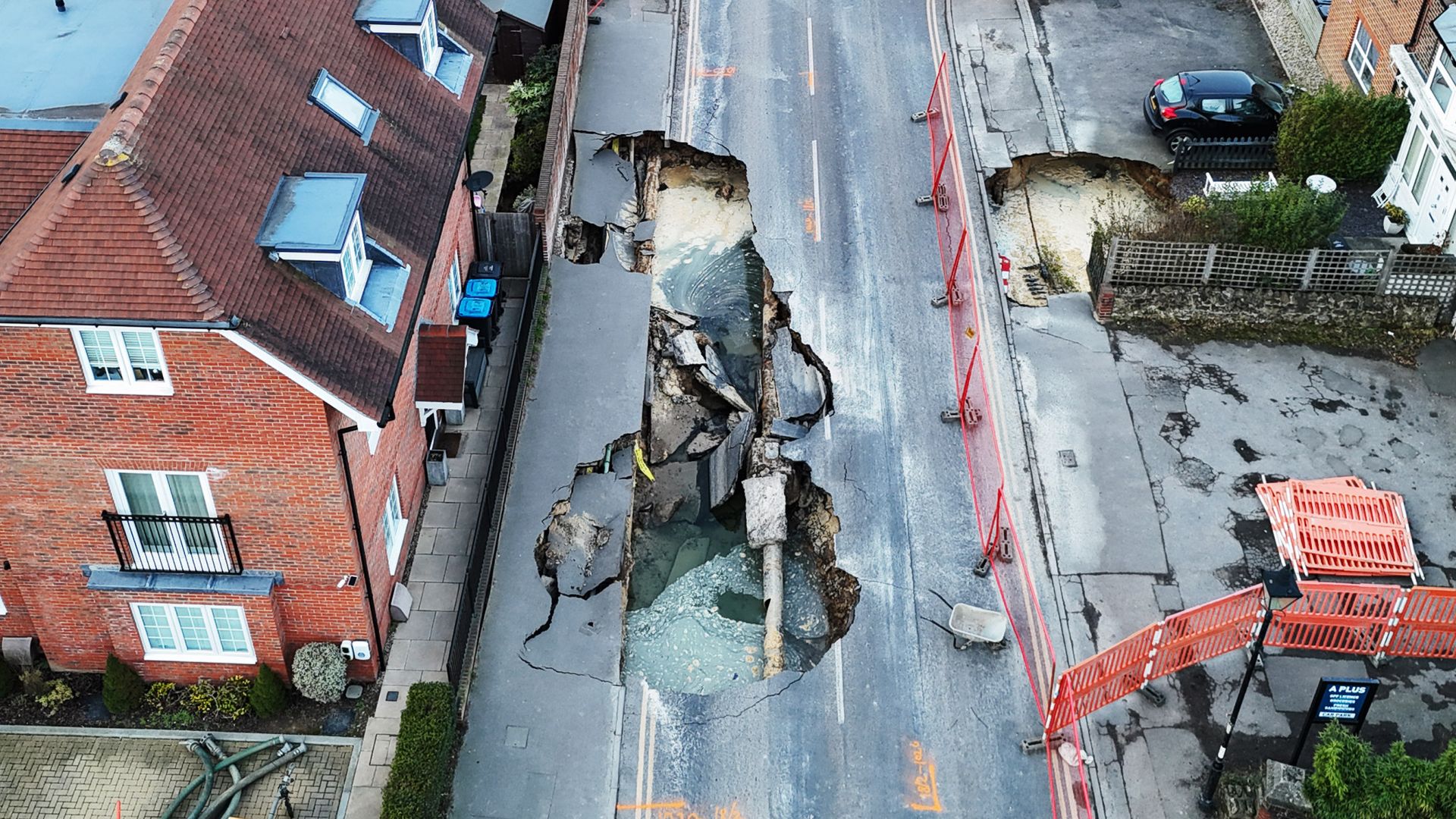A major incident has been declared in a village in Surrey after a large sinkhole opened up.
At least one garden in Godstone has been swallowed by the hole – which is believed to measure up to 62ft (19m) – and around 30 homes have been evacuated.
Carl Bussey, assistant director of safer communities at Surrey County Council, said on Wednesday that the site continues to be “assessed by structural experts, in order to manage the risk and understand what needs to be done to make safe and repair”.
What actually caused the hole to open up, remains unknown.
Provider SES Water said the sinkhole caused a water pipe to burst, leading to some residents losing their supply – which have now all been restored.
Residents in the area are no strangers to sinkholes, having also experienced one in 2019 – albeit this was only “slight” and did not cause the same extent of damage.
The most recent Surrey sinkhole also occurred mere months after a large sinkhole appeared in Merthyr Tydfil, South Wales, which ate up the driveway of former Love Island winner Liam Reardon’s family home.
Back in September last year, AFC Wimbledon had to postpone a Carabao Cup third-round rematch after severe flooding caused what appeared to be a large sinkhole on the pitch at Cherry Red Records Stadium.
So what is causing these sinkholes, and why have more seemingly started to appear in the UK?
Please use Chrome browser for a more accessible video player
What is a sinkhole?
Sinkholes are often saucer-shaped holes that occur as the result of a collapse or removal of an underlying layer of rocks that is used to support the materials on the surface, the British Geological Survey (BGS) says.
The shape of a sinkhole depends on the composition of the rocks underneath the surface and the different interacting processes taking place, according to the BGS.
Sinkholes that result from the removal of a soluble rock such as chalk, gypsum or limestone are called solution sinkholes.
Streams or rivers that enter a sinkhole and disappear underground are known as shallow holes.
What causes a sinkhole?
“The main trigger for sinkholes is water,” Dr Clive Edmonds, a geotechnical specialist who has studied sinkholes for 30 years, told The Institution of Civil Engineers (ICE).
He said in 90% of cases, water saturating the ground is the main cause of collapse.
Dr Edmonds adds that geology is also a main factor in the development of a sinkhole. The more soluble the rock, the more likely a sinkhole is to occur.
Soluble rocks that are broken down by water form karst, a type of landscape that is characterised by sinkholes and underground caves.
Building works, changes in water table level and mining can also trigger sinkholes, the BGS says.
Commenting specifically on Godstone, Dr Philip Collins, deputy dean at Brunel University’s College of Engineering, said the land immediately west of where the sinkhole appears was formerly used as a sand quarry.
“Sand can be strong when compacted as the particles are packed together, but weak when it becomes wet, and particularly if there is a lot of water under pressure,” he said, suggesting the local geology contributed to the formation of the sinkhole.
He added that in this case the sinkhole appears to have been caused by a “washout of soil from beneath the road as a result of a burst water mains”.
“This burst would have pumped a large volume of water into the soil in a short period of time, overcoming its strength and turning it to a slurry which was then washed away. It isn’t clear where the soil went yet, but it is likely to have gone into the sewers, which may cause problems elsewhere,” he said.
Andrew Farrant, a regional geologist for the BGS agreed.
He said the “cross-bedded sands” and “weakly cemented sandstones” that Godstone is build upon are “prone to erosion and flushing by running water”.
But adds that this would normally not be a problem “unless there is a sudden change in the hydrogeology, for example by digging a large hole below the local water table or due to a sudden ingress of water, from say a burst pipe, or heavy rainfall or flooding.
“It is probable that a burst water main has flushed out weak sandstone bedrock, creating a void which has then collapsed,” Mr Farrant said.
He noted the “actual cause” of the sinkhole cannot be defined without further information.
SES Water, which provides water in the area, maintains the burst main was caused after the sinkhole occurred and not the other way around.
Be the first to get Breaking News
Install the Sky News app for free
What areas of the UK are prone to sinkholes?
The BGS says most sinkholes are relatively small and occur in upland or rural areas.
Areas like the Mendip Hills in Somerset, parts of Wales, the Peak District and the Yorkshire Dales are susceptible because they are built on Carboniferous limestone – a hard sedimentary rock made largely of calcium carbonate.
The most sinkhole-susceptible area in the UK, is the Permian gypsum deposits of northeast England, particularly around Ripon, the BGS says.
Sinkholes also occur over salt deposits, commonly in areas such as Cheshire. While on the west coast of Scotland, parts of Assynt are prone to sinkholes due to the underlying Cambrian Durness Limestone.
Can you predict or prevent a sinkhole?
Often the first indicators of a sinkhole are dips and depressions on ground surfaces, Dr Edmonds told The Institution of Civil Engineers.
When these leaks and cracks fill with water it can potentially lead to buildings moving, leaks in water mains or sewer water leaking on to the ground.
Geobear, a ground and structural engineering company based in the UK, says strengthening the ground in high-risk areas prone to sinkholes may help to prevent them from opening up.
They do that by injecting geopolymer resin into the affected area, which binds with the soil and allows properties to withstand any sinkholes far more effectively.
The company adds that homeowners worried about sinkholes forming can help prevent them by calling professionals, installing proper drainage systems and planting vegetation around a property to help absorb rainwater run off, instead of it collecting in pools.
Follow our channel and never miss an update
Not just a UK problem…
Sinkholes are not just a problem in the UK, and recent examples from across the globe show just how dangerous the phenomena can be.
At the beginning of the year, a rescue mission was launched in Yashio, Japan, after a truck and its driver were swallowed by a swimming pool-sized sinkhole.
Aerial footage shown by local broadcaster Nippon TV showed at least 12 fire engines trying to free the driver, who was reportedly trapped in his vehicle after it filled with sand and mud.
The search went on for two weeks before being called off by officials, who were worried the ground would further collapse, Japanese news agency Kyodo News reported on 10 February.
In December 2024, the body of Elizabeth Pollard, 64, was found in a sinkhole in Pennsylvania. The grandmother was last seen searching for her cat Pepper in the village of Marguerite, about 40 miles east of Pittsburgh, before she was found days later where a sinkhole had recently opened up above an area where coal was mined 70 years prior.
Sinkholes are also not uncommon in China. In 2020, nine people died after a sinkhole swallowed an entire bus outside a hospital in the city of Xining, in Qinghai province. Another 17 people were injured in the event.
And in 2010, a giant sinkhole opened up in Guatemala City, caused by the rains of Tropical Storm Agatha and making for some jaw-dropping pictures.






